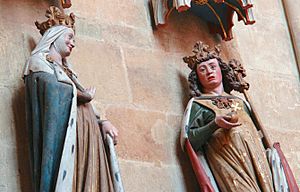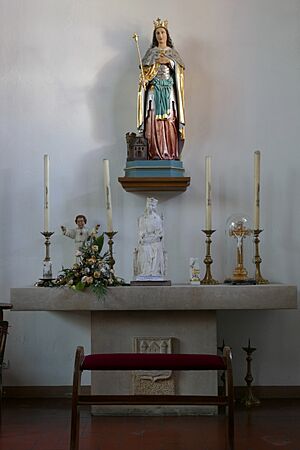Adelaide of Italy facts for kids
Quick facts for kids SaintAdelaide of Italy |
|
|---|---|
 |
|
| Born | 931 Orbe, Upper Burgundy |
| Died | 16 December 999 (aged 68) Seltz, Alsace |
| Venerated in | Catholic Church Eastern Orthodox Church |
| Canonized | 1097 by Pope Urban II (Catholicism) |
| Feast | 16 December |
| Attributes | dispensing alms and food to the poor, often beside a ship |
Adelaide of Italy (German: Adelheid; 931 – 16 December 999 AD), also known as Adelaide of Burgundy, was a powerful queen and empress in the Middle Ages. She became Holy Roman Empress by marrying Emperor Otto the Great. They were crowned together by Pope John XII in Rome on February 2, 962. Adelaide was the first empress to be called consors regni, which meant she was a "co-bearer of royalty" and shared power with her husband. She was a very important example for future queens, showing how much influence they could have. She also ruled the Holy Roman Empire for her young grandson from 991 to 995.
Contents
Adelaide's Life Story
Her Early Years
Adelaide was born in Orbe Castle, in the Kingdom of Upper Burgundy (which is now part of Switzerland). Her parents were Rudolf II of Burgundy and Bertha of Swabia.
From a young age, Adelaide was involved in the complicated struggles to control both Burgundy and a region in northern Italy called Lombardy. Her father, Rudolf II, fought against Berengar I of Italy for control of northern Italy. When Berengar died, Rudolf was able to claim the throne.
However, the people of Lombardy were not happy. They asked for help from Hugh of Provence, who was an enemy of Rudolf. Hugh tried to take over the Burgundian throne, and he succeeded when Adelaide's father died in 937. To gain control of Upper Burgundy, Hugh decided to marry his son, Lothair II of Italy, to the 15-year-old Adelaide. This marriage happened in 947.
Adelaide and Lothair had one daughter, Emma of Italy, born around 948. Emma later became Queen of West Francia by marrying King Lothair of France.
Marriage to Otto the Great
According to historical records, Lothair died suddenly on November 22, 950. Many suspected he was poisoned by Berengar II of Italy, who then took power.
Some people in Lombardy thought Adelaide wanted to rule the kingdom by herself. Berengar tried to stop her and make his own power stronger by forcing her to marry his son, Adalbert of Italy. Adelaide refused and escaped, hiding in the castle of Como. But she was quickly found and held prisoner for four months at Garda, Veneto.
Adelaide's biographer, Odilo of Cluny, wrote that she managed to escape from prison. After hiding in nearby marshes, a priest rescued her and took her to a very strong fortress, probably Canossa Castle. From there, she sent a messenger to the king of the East Frankish kingdom, Otto I, Holy Roman Emperor. She asked him for protection. Adelaide met Otto in Pavia, the old capital of the Lombards, and they married on September 23, 951. Early in their marriage, Adelaide and Otto had two sons, Henry and Bruno, but both died when they were young.
A few years later, in 953, Otto's son from his first marriage, Liudolf, Duke of Swabia, started a large uprising. Otto put down the revolt and took away Liudolf's title. This decision helped Adelaide and her children gain more influence in the royal court. Adelaide also kept all her lands that came with her marriage.
After returning to Germany with his new wife, Otto made the Holy Roman Empire stronger. He defeated Hungarian invaders at the Battle of Lechfeld on August 10, 955. He also expanded the borders of his kingdom by defeating Slavic groups. In that same year, Adelaide gave birth to Otto II, Holy Roman Emperor. In 955 or 956, she had another daughter, Matilda, Abbess of Quedlinburg.
Becoming Holy Roman Empress
Adelaide joined her husband on his second trip to Italy. They went to stop a revolt by Berengar II and to protect Pope John XII. In Rome, Otto the Great was crowned Holy Roman Emperor on February 2, 962, by Pope John XII. Breaking new ground, Pope John XII also crowned Adelaide as Holy Roman Empress. This was a very important moment, as it showed her power and special role.
Adelaide stayed in Rome for six years while Otto ruled his kingdom from Italy. Their son, Otto II, was crowned co-emperor in 967. He then married the Byzantine princess Theophanu in April 972. This marriage helped solve problems between the two empires and made sure the imperial family would continue. Adelaide and her husband returned to Germany, where Otto I died in May 973.
After her coronation, Adelaide's involvement in political decisions grew. She was now consors regni, meaning she shared in the royal power. She often helped religious groups and institutions, which gave her influence separate from her husband's. Many people, including important church leaders, asked for her protection and help. This shows how powerful and respected Adelaide was.
For example, her daughter Emma of Italy wrote to Adelaide in the 980s. Emma asked her mother to help against her enemies and to gather forces in the Ottonian Empire. She even asked Adelaide to capture Hugh Capet, who later became king of West Francia. Another important person, Gerbert of Aurillac (who later became Pope Sylvester II), also wrote to Adelaide asking for her protection. These requests show that people believed Adelaide had the power to help them, even if they were important leaders themselves.
Otto II's Reign
After Otto I died, Adelaide still had a lot of influence at court. However, she had some disagreements with her daughter-in-law, Theophanu, because only one woman could be the main queen. Adelaide kept her title imperatrix augusta, even though Theophanu also used it. Theophanu also disagreed with Adelaide about how she used her dowry lands, which Adelaide wanted to give to churches. Adelaide had the right to manage her Italian lands as she wished, but she needed the emperor's permission for her German lands.
Adelaide also supported her relatives against her own son, Otto II. In 978, Otto II sent her away from court to Burgundy. She then spent her time between the royal palace in Pavia, Italy, and Arles, France, with her brother Conrad I of Burgundy. Through him, she eventually made peace with her son. In 983, just before he died, Otto II made her his special representative in Italy.
Adelaide as Regent
In 983, her son Otto II died. Adelaide's grandson, Otto III, Holy Roman Emperor, became emperor, but he was very young. Theophanu became his regent (ruler in his place) while Adelaide stayed in Italy. For a while, Adelaide and Theophanu worked together to make sure Otto III became emperor. They even appeared together in official documents.
When Theophanu died in 990, Adelaide became the regent for Otto III until he was old enough to rule on his own, which was four years later. Otto III himself wrote to his grandmother in 996, saying that God had given him the empire "according to your [Adelheid’s] wishes and desires." This shows how important Adelaide was in helping him become emperor.
Even after Otto III became an adult, Adelaide often traveled with him and continued to influence him.
Later Years and Legacy
Adelaide stepped down as regent in 995 when Otto III was declared old enough to rule. From then on, she focused on helping others and supporting the church. She founded and restored many religious places like monasteries, churches, and abbeys.
Adelaide had strong connections with Cluny Abbey, which was a center for church reform at the time. She retired to a nunnery she had founded around 991 at Selz Abbey in Alsace.
Adelaide died at Selz Abbey on December 16, 999. She was on her way to Burgundy to help her nephew, Rudolph III of Burgundy, with a rebellion. She died just days before the year 1000, which many people at the time thought would bring the Second Coming of Christ. She was buried in the Abbey. Pope Urban II made her a saint in 1097. After a big flood in 1307, Adelaide's relics (holy remains) were moved to another place. A special cup believed to belong to Saint Adelaide has been kept in Seltz for a long time. It was used to give drinks to sick people, and many healings were said to have happened.
Adelaide always worked for the church, for peace, and for the empire. She also cared about converting the early Slavs to Christianity. She played a key role in shaping the religious culture of Central Europe at the end of the Early Middle Ages. Some of her relics are kept in a shrine in Hanover. Her feast day, December 16, is still celebrated in many German churches.
Adelaide's Children
Adelaide had children from her two marriages:
In 947, Adelaide married King Lothair II of Italy. They had one child:
- Emma of Italy (born 948 – died after 987), who became Queen of France and wife of Lothair of France.
In 951, Adelaide married King Otto I, who later became Holy Roman Emperor. They had four children:
- Henry (952 – April 7, 954)
- Bruno (953 – September 8, 957)
- Matilda (early 955 – † February 6, 999), who became the first leader of Quedlinburg Abbey.
- Otto II (late 955 – December 7, 983), who later became Holy Roman Emperor.
Adelaide in Art and Stories
Adelaide was one of the most important and powerful female rulers in the Middle Ages. She is often shown as a strong and wise leader, but also as a kind and religious woman.
How She is Shown in Art
Adelaide is usually shown wearing royal clothes, with a scepter and a crown. Since the 14th century, she is also sometimes shown with a model church or a ship. The ship represents how she escaped from being held captive.
One famous artwork of Adelaide is a sandstone statue in Meissen Cathedral in Germany, made around 1260. She is shown there with her husband, Otto I, because they helped found the church.
Operas and Books About Her
Adelaide of Burgundy has been the main character in several operas:
- l'Adelaide (1672) by Antonio Sartorio.
- An opera from 1723 by Nicola Porpora, where a famous singer named Farinelli played Adelaide.
- Lotario (1729) by George Frideric Handel, which tells a fictional story based on Adelaide's life.
- Adelaide di Borgogna (1817) by Gioachino Rossini.
She has also appeared in books and novels:
- Adelheid, Mutter der Königreiche (Adelaide, Mother of Kingdoms) by Gertrud Bäumer (1936).
- Die fremde Königin (The Foreign Queen) by Rebecca Gablé (2017), where Adelaide is a main character.
- Empress Adelheid and Countess Matilda: medieval female rulership and the foundations of European society by Penelope Nash (2017).
- Imperial ladies of the Ottonian Dynasty: women and rule in tenth-century Germany by Phyllis G. Jestice (2018).
- God's Maidservant: The story of Adelaide of Italy (Women of the Dark Ages) by Anna Chant (2017).
Other Artworks
- San Giuseppe con Gesù Bambino tra Sant'Adelaide, Sant'Antonio da Padova, San Lupo e San Michele arcangelo by Francesco Coghetti, 1828.
- Adelaide is also featured in Judy Chicago's famous art installation The Dinner Party. Her name is one of 999 names on the Heritage Floor, celebrating important women throughout history.
See Also
 In Spanish: Adelaida de Italia para niños
In Spanish: Adelaida de Italia para niños
- List of Eastern Orthodox saints
- List of Holy Roman empresses
- List of Catholic saints
- Saint Adelaide, patron saint archive




